The question is, At what size should you put a vegetable seeding into the ground or a bigger pot? The answer is, At any size before the seedling is rootbound. Rootbound means the roots in the container are crowded and circling, especially at the bottom.
Let me illustrate with photos. Above is my cart of vegetable seedlings, as of yesterday. I caught a cold last week so some of the vegetable seedlings I would have transplanted earlier were left in their containers longer than ideal while others I suspect still aren’t ready for transplanting.
Let’s look at some individual plants. First, a Jericho lettuce plant.
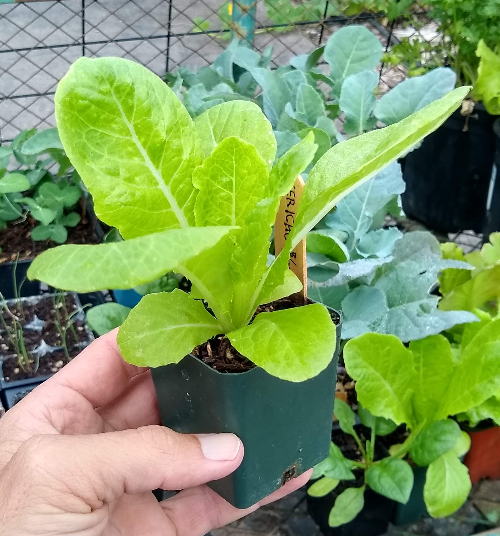
Now I pop the plant out of its container to look at the roots.
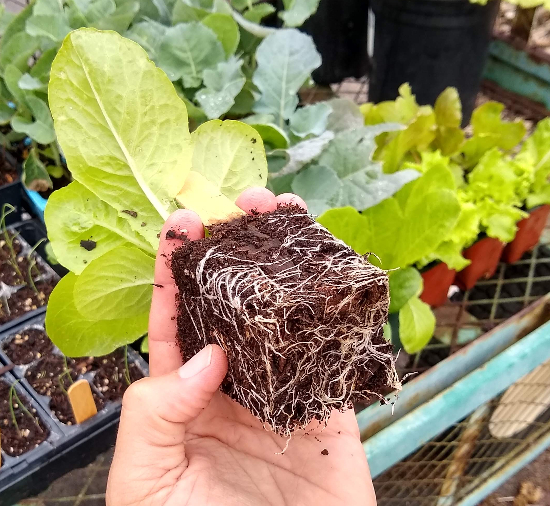
Perfect timing. This is what I want the roots to look like when I either put the plant into a bigger pot or into the ground. The roots have filled out the volume of soil, but they aren’t too crowded yet.
Second, a Space spinach plant.

Above ground the plant seems small . . . and the roots?

Not ready for transplanting. There is still soil for the roots to exploit, as you can see by some crumbling onto my palm. A full rootball will hold together.
Now you can transplant this spinach plant. If you’ve got a spot in the garden ready for it, and you’ve got the time to do it only now, go for it. But if you want to grow it in this container as long as is healthy, then you could wait another week or so.
Third, this Tendersweet cabbage plant.
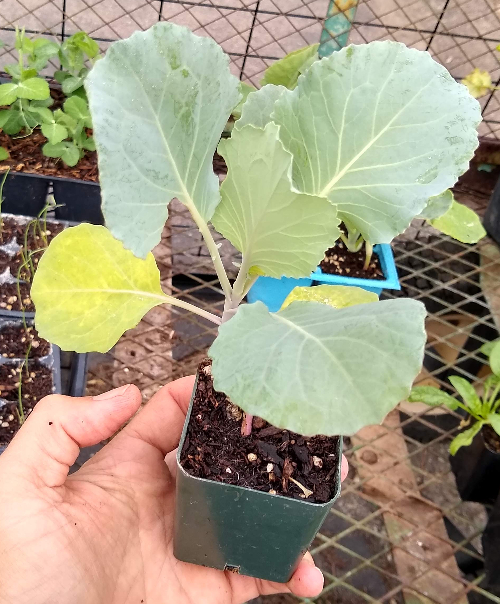
Pretty big plant. How about the roots?

There are way too many roots for that volume of compost. All I see are roots. The plant needs access to more compost or soil. It should have been put into a bigger pot or the ground last week (while I was nursing my cold).
Did you notice the yellowing lower leaves?

That indicates that the plant is no longer getting all of the nutrients it needs from the soil/compost that its roots are in. It needs more. The plant is being stunted.
Two more plants. But since I’ve already shown and explained when I like to pot up or transplant seedlings, I’ll let you answer these ones. First, my onions.

Let’s look at the roots of the biggest plant.
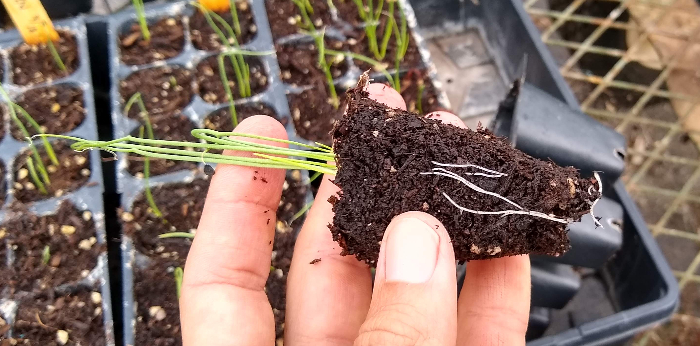
Pot up or plant now, or wait? Why?
And finally, my peas:

The roots of the biggest plant.
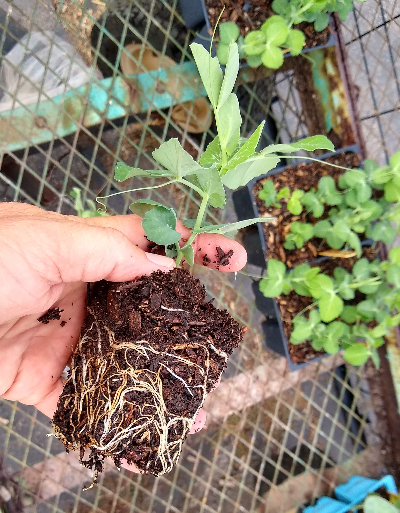
What do you say? Ready for potting up or transplanting, not ready yet, or waited too long?
Here are a couple related posts that might interest you:
“The art of transplanting a vegetable seedling (in five steps)”
“Should you grow vegetables from seeds or plants?”
“Comparing four mixes for starting vegetable seeds”
“Sowing vegetable seeds in the ground in Southern California: three keys to success”
All of my Yard Posts are listed HERE
Please consider becoming a Yard Posts Supporter

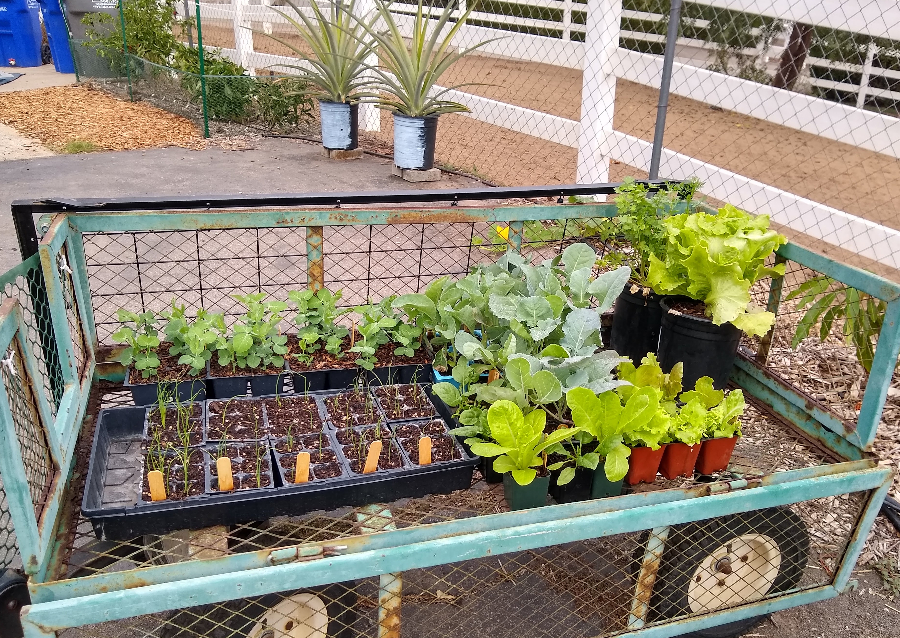


Hi Greg,
Well we are finally, after two and a half years are harvesting our first crop of Reeds and Lamb Hass, some really handsome avocados. One thing in regards to the generous application of mulch we put around the trees is a bumper crop of grubs. Peeling back the top layer of mulch reveals these root munching pests. We have used neem oil in a soak that seems to do a pretty good job of reducing their numbers.I recently lost two young trees and when removing them it looked like the surface roots had been severely destroyed by grubs. Can you recommend anything else that would be effective? I guess your chickens make a meal out of any in your yard. No chickens here.
Mahalo
Greg H
Hi Greg,
I’ve never noticed grubs in the mulch being a problem. As you said, my chickens do a certain amount of control under my trees, but I still have some around. That being said, I can imagine that if the population were high enough, the damage could be significant.
My thoughts are that you could use a rake to move around the mulch and expose some of the grubs this time of year. Either gather them or just figure that birds will likely show up and eat some after you walk away.
Also, in the spring and summer when they’ve become flying adults (June bugs or green fruit beetles or whatever they are), you can do some control of them. I just go out a few nights in a row to a particular avocado tree and gather June bugs, and that makes a big difference in that individual spot for a time. See this post: https://gregalder.com/yardposts/who-is-eating-holes-in-your-avocado-leaves/
I’m thinking that between some control of larvae and some control of adults, you can lower their numbers enough to insignificant damage levels. There are probably insecticides you could try too, but that might not be necessary with a little bit of hand work here and there.
Good morning Greg,
Can you let me know if you start your seeds indoors under a grow light or outdoors without any supplemental light?
I seemed to have pretty bad germination this past year starting seeds solely in my greenhouse without any supplemental light.
Hi Yolanda,
I start my seeds indoors usually, but without lights. As soon as they’ve germinated, I put them in real sun. I’m a simple gardener: no heating mats, no greenhouses, no lights.
I haven’t found a single type of vegetable seed that needs any light in order to germinate, not more light than is in my garage naturally anyway. I’ve heard some say that lettuce needs light, for example, but I haven’t found that to be true.
Possible explanations for bad germination are many, but the most common are old seeds, inappropriate temperature, and inappropriate soil moisture. Might any of those have affected your seeds this past year?
Hi Greg,
Hoping you can provide a comment on whether you think this particular avocado tree is worth purchasing. Its in a 15 gal container, is about 3ft high from the top of the container to the top of the tree. Its a GEM and Ive looked locally in Orange county Calif, and this is the only 15 gal at this time of the year. The question is… the main trunk coming from the rootstock is about 1.25 inches, the graft comes out of the rootstock at 1:30PM(referencing a clock) so it comes out at an angle and is 3/4 inches and then goes into a “Y” branch. But does come up straight as it exits the side of the rootstock. My concern is….is this going to be a weak main trunk as it matures since it comes out at an angle or , will this mature well and grow up straight. I am reluctant to get a 5 gallon due to years before it matures and produces fruit. Your advice is appreciated.
Hi Al,
The angle will not be a problem at that young age. Over time, it will actually disappear, and the tree as a whole will grow straight up, perhaps needing a bit of pruning later. I’ve grown trees like this before.
However, does the graft union look healthy? That is all I would be concerned about. Does it have white powder on it, for example (which comes from wounding)?
Hi Greg, thank you so much for your response.
i attempted to include a picture, but cannot. The grafted 15 gal tree was from the nursery picture. I am going to go to see it.
My yard is pretty small. I have only enough room for 3 trees. I have a 7ft Pinkerton that was a 15 gallon and unfortunately, the branches got burned two summers ago and ALL the branches are pretty skinny , damaged by the sunburn and dont look like they will support future avocados. I planted it 4 yrs ago and only produced the first year. Due to the space constraints my intention is to cut a hole VERY close within 8 inches from the main trunk and plant this new tree. I realize I may kill the Pinkerton, but my choice is to remove it or chance kilting it to plant this NEW avocado tree. I may pour in a lot of B12 for root shock. Any suggestions is appreciated, I think So Cal winter is when I will do the planting in the ground.
I really want to thank you for your advice on this new tree.
Very much appreciated
Al
Hi Greg, Do you plant your seedlings in 100% compost? Is that the same thing as mulch?
Hi Ari,
Yes, I do. See these posts:
https://gregalder.com/yardposts/can-you-start-vegetable-seeds-in-compost/
https://gregalder.com/yardposts/experiment-comparing-composts-for-vegetable-seed-starting/
https://gregalder.com/yardposts/comparing-four-mixes-for-starting-vegetable-seeds/
Compost is not the same as mulch. Mulch, at least the way most people use term, is something you lay on the surface of the dirt. It can be made of wood chips, plastic, gravel, or compost.
Compost is plant material and sometimes manures that have decomposed so well and for so long that you can barely identify the constituents.